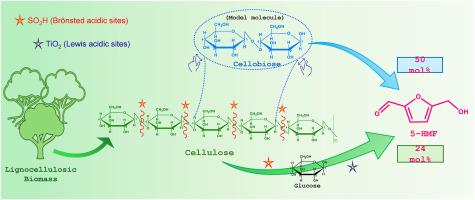Enhanced catalytic conversion of cellobiose/cellulose to 5-hydroxymethylfurfural using dual catalysts: Sulfonated activated carbon and Lewis acid catalyst
IF 5.8
2区 生物学
Q1 AGRICULTURAL ENGINEERING
引用次数: 0
Abstract
An activated carbon (SX+) was functionalized with sulfonic groups via the diazonium coupling method to impart Brӧnsted (B) acidity to catalyze cellobiose and cellulose upgrading into 5-HMF. X-ray photoelectron spectroscopy (XPS) confirmed SO3H groups grafting, which significantly enhanced the total acidity to 1.33 mmol/g cat., as confirmed by Boehm titration. The B nature of acidity was verified by 31P ssNMR. The catalytic activity of SO3H/SX+ alone and with AlCl3 as Lewis (L) acid was evaluated by optimizing reaction conditions such as temperature, solvent, and B/L ratio. A ∼47 % 5-HMF yield was obtained with 100 % cellobiose conversion at 150 °C, 4 h with SO3H/Al ratio of 1:10 in Milli-Q water (MQ)/tetrahydrofuran (THF) solvent. When AlCl3 was replaced with heterogeneous Lewis acidic catalysts (γ-Al2O3, AlOOH, and TiO2), TiO2 combined with SO3H/SX+ showed similar catalytic activity, achieving ∼50 % yield of 5-HMF with 100 % cellobiose conversion, attributed to its high total acidity (2.4 × 10−2 mol/g cat.). 5-HMF was isolated from the reaction mixture using liquid-liquid extraction, resulting in ∼98 % pure 5-HMF. Moreover, SO3H/SX+ efficiently cleaved the glycosidic bonds of microcrystalline cellulose by giving a ∼24 % 5-HMF yield when combined with Lewis acid TiO2. This study presents a novel dual catalytic system, utilizing an optimized B/L acidity ratio to achieve efficient cellulose conversion into 5-HMF.

采用磺化活性炭和路易斯酸催化剂增强纤维素二糖/纤维素催化转化为5-羟甲基糠醛
通过重氮偶联法将活性炭(SX+)与磺酸基进行官能团化,赋予Brӧnsted (B)酸性,催化纤维素二糖和纤维素升级为5-羟甲基糠醛。x射线光电子能谱(XPS)证实了SO3H基团接枝,使总酸度显著提高到1.33 mmol/g cat。,由Boehm滴定法证实。用31P ssNMR验证了酸性的B性质。通过优化反应温度、溶剂、B/L比等条件,考察了SO3H/SX+单独和AlCl3作为Lewis (L)酸的催化活性。在ml - q水(MQ)/四氢呋喃(THF)溶剂中,100%纤维素二糖在150°C、SO3H/Al比为1:10的条件下转化4 h, 5-HMF收率为47%。当AlCl3被非均相Lewis酸性催化剂(γ-Al2O3, AlOOH和TiO2)取代时,TiO2与SO3H/SX+结合表现出类似的催化活性,由于其高总酸度(2.4 × 10−2 mol/g cat), 5-HMF的收率达到~ 50%,纤维二糖转化率为100%。用液-液萃取法从反应混合物中分离出5-HMF,得到5-HMF纯度约98%。此外,当SO3H/SX+与Lewis酸TiO2结合时,通过给予~ 24%的5-HMF产率,SO3H/SX+有效地切割微晶纤维素的糖苷键。本研究提出了一种新的双催化系统,利用优化的B/L酸度比实现纤维素高效转化为5-羟甲基糠醛。
本文章由计算机程序翻译,如有差异,请以英文原文为准。
求助全文
约1分钟内获得全文
求助全文
来源期刊

Biomass & Bioenergy
工程技术-能源与燃料
CiteScore
11.50
自引率
3.30%
发文量
258
审稿时长
60 days
期刊介绍:
Biomass & Bioenergy is an international journal publishing original research papers and short communications, review articles and case studies on biological resources, chemical and biological processes, and biomass products for new renewable sources of energy and materials.
The scope of the journal extends to the environmental, management and economic aspects of biomass and bioenergy.
Key areas covered by the journal:
• Biomass: sources, energy crop production processes, genetic improvements, composition. Please note that research on these biomass subjects must be linked directly to bioenergy generation.
• Biological Residues: residues/rests from agricultural production, forestry and plantations (palm, sugar etc), processing industries, and municipal sources (MSW). Papers on the use of biomass residues through innovative processes/technological novelty and/or consideration of feedstock/system sustainability (or unsustainability) are welcomed. However waste treatment processes and pollution control or mitigation which are only tangentially related to bioenergy are not in the scope of the journal, as they are more suited to publications in the environmental arena. Papers that describe conventional waste streams (ie well described in existing literature) that do not empirically address ''new'' added value from the process are not suitable for submission to the journal.
• Bioenergy Processes: fermentations, thermochemical conversions, liquid and gaseous fuels, and petrochemical substitutes
• Bioenergy Utilization: direct combustion, gasification, electricity production, chemical processes, and by-product remediation
• Biomass and the Environment: carbon cycle, the net energy efficiency of bioenergy systems, assessment of sustainability, and biodiversity issues.
 求助内容:
求助内容: 应助结果提醒方式:
应助结果提醒方式:


